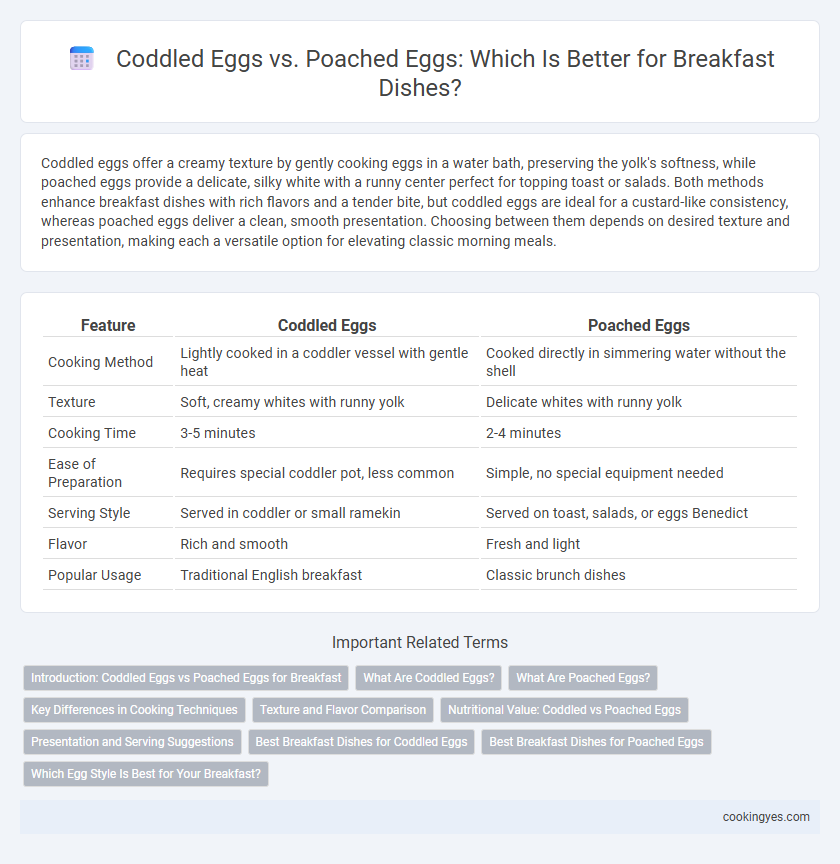Coddled eggs offer a creamy texture by gently cooking eggs in a water bath, preserving the yolk's softness, while poached eggs provide a delicate, silky white with a runny center perfect for topping toast or salads. Both methods enhance breakfast dishes with rich flavors and a tender bite, but coddled eggs are ideal for a custard-like consistency, whereas poached eggs deliver a clean, smooth presentation. Choosing between them depends on desired texture and presentation, making each a versatile option for elevating classic morning meals.
Table of Comparison
| Feature | Coddled Eggs | Poached Eggs |
|---|---|---|
| Cooking Method | Lightly cooked in a coddler vessel with gentle heat | Cooked directly in simmering water without the shell |
| Texture | Soft, creamy whites with runny yolk | Delicate whites with runny yolk |
| Cooking Time | 3-5 minutes | 2-4 minutes |
| Ease of Preparation | Requires special coddler pot, less common | Simple, no special equipment needed |
| Serving Style | Served in coddler or small ramekin | Served on toast, salads, or eggs Benedict |
| Flavor | Rich and smooth | Fresh and light |
| Popular Usage | Traditional English breakfast | Classic brunch dishes |
Introduction: Coddled Eggs vs Poached Eggs for Breakfast
Coddled eggs, gently cooked in a water bath within a small container, offer a creamy texture and retain more moisture compared to poached eggs, which are cooked directly in simmering water resulting in a tender white encasing a runny yolk. Both methods preserve the delicate flavor of eggs, making them ideal for breakfast dishes like toast soldiers or salad toppings. Nutrient retention is slightly higher in coddled eggs due to the controlled cooking environment, enhancing protein quality and bioavailable vitamins.
What Are Coddled Eggs?
Coddled eggs are gently cooked eggs prepared by placing them in a small dish or coddling pot, often submerged in hot water to achieve a tender, custard-like texture without scrambling. This method preserves the yolk's creaminess while lightly setting the whites, offering a delicate alternative to poached eggs, which are cooked directly in simmering water. Coddled eggs provide a consistent, soft-cooked result ideal for breakfast dishes that require a smooth, velvety egg preparation.
What Are Poached Eggs?
Poached eggs are eggs gently cooked in simmering water without their shells, resulting in tender whites and runny yolks that complement a variety of breakfast dishes. Unlike coddled eggs, which are steamed or gently cooked in a small container, poached eggs are directly exposed to water, creating a delicate texture ideal for toppings on toast, salads, or eggs Benedict. This cooking method preserves the egg's flavor while offering a healthy, low-fat alternative rich in protein and essential nutrients.
Key Differences in Cooking Techniques
Coddled eggs are gently cooked in a small container placed in hot water, allowing the whites to set softly while the yolk remains runny, creating a delicate texture. Poached eggs are cracked directly into simmering water, which cooks the egg quickly and produces a tender white enveloping a molten yolk. The key difference lies in coddling using a controlled vessel for gentle heat application versus poaching relying on direct water immersion for quicker cooking.
Texture and Flavor Comparison
Coddled eggs offer a creamy, custard-like texture with a delicate, mildly rich flavor due to gentle cooking in a water bath, maintaining a soft yet slightly set white and runny yolk. Poached eggs feature a tender, silky white enveloping a warm, runny yolk, providing a lighter texture with a fresh, clean taste enhanced by the absence of shell cooking. Texture-wise, coddled eggs are denser and softer, while poached eggs deliver a more delicate mouthfeel with pronounced contrast between the white and yolk.
Nutritional Value: Coddled vs Poached Eggs
Coddled eggs retain more nutrients due to gentle cooking within a vessel, preserving delicate vitamins like B12 and folate, while poached eggs are cooked directly in water, minimizing added fats and calories. Both methods yield high-quality protein and essential amino acids for muscle repair and metabolic function. Poached eggs tend to have slightly lower cholesterol levels on the surface because some fats are rendered into the cooking water, making them ideal for heart-conscious diets.
Presentation and Serving Suggestions
Coddled eggs boast a delicate, creamy texture served in charming porcelain cups, making them ideal for elegant brunch presentations paired with toasted soldiers or fresh herbs. Poached eggs present a sleek, velvety white exterior encasing a runny yolk, commonly served atop avocado toast, English muffins, or salads for a visually appealing yet rustic dish. Both styles enhance breakfast aesthetics but differ in serving versatility, with coddled eggs suited for refined plating and poached eggs offering more casual, hearty options.
Best Breakfast Dishes for Coddled Eggs
Coddled eggs offer a creamy texture and delicate flavor, making them ideal for luxurious breakfast dishes such as eggs Benedict or smoked salmon with caviar. Their gentle cooking method preserves nutrients and allows for easy incorporation of herbs and cheeses, enhancing breakfast bowls or toast toppings. Compared to poached eggs, coddled eggs provide a richer taste experience while maintaining a smooth, tender consistency perfect for gourmet morning meals.
Best Breakfast Dishes for Poached Eggs
Poached eggs are ideal for breakfast dishes like Eggs Benedict, avocado toast, and salads, offering a delicate texture that complements rich hollandaise or creamy avocado. Compared to coddled eggs, poached eggs provide a lighter, healthier option since they are cooked in water without added fats. Their runny yolk enhances flavors and adds a luxurious mouthfeel, making them a versatile choice for gourmet breakfast recipes.
Which Egg Style Is Best for Your Breakfast?
Coddled eggs offer a creamy texture with gently cooked whites and runny yolks, ideal for a delicate breakfast dish. Poached eggs provide a firmer white while maintaining a soft, runny yolk, perfect for dishes like Eggs Benedict. Choosing between coddled and poached eggs depends on preferred texture and presentation in your breakfast.
Coddled eggs vs Poached eggs for breakfast dishes Infographic

 cookingyes.com
cookingyes.com